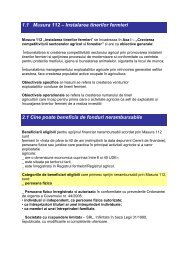2011 - Europe Direct Iasi
2011 - Europe Direct Iasi
2011 - Europe Direct Iasi
Create successful ePaper yourself
Turn your PDF publications into a flip-book with our unique Google optimized e-Paper software.
R.22.<br />
Title<br />
Authors<br />
Institution<br />
Description<br />
R.23.<br />
EUROINVENT <strong>2011</strong><br />
new substances.<br />
The database has a public character, being accessible online<br />
for researchers, teachers, students, doctoral students, producers,<br />
and generally for anyone wishing to obtain specialized<br />
information, complete information on these substances.<br />
Operation of the information provided in this database<br />
allows us to draw conclusions about the mode of action of<br />
antibacterial biocides on different materials, on the toxicity and<br />
ecotoxicity so we can manage the potential risks of biocides.<br />
Environmentally friendly pulping and bleaching of<br />
agricultural residues<br />
Tofanica B.M., Puitel A.C., Gavrilescu D.<br />
"Gheorghe Asachi" Technical University of <strong>Iasi</strong><br />
Faculty of Chemical Engineering and Environmental<br />
Protection, Natural and Synthetic Polymers Department<br />
The aim of this study is to investigate the possibilities of<br />
producing chemical pulp with low residual lignin content from<br />
rapeseed stalks by means of conventional sulphur-free pulping<br />
followed by oxygen delignification. Chemical pulping was<br />
carried out by soda-anthraquinone method under varying<br />
conditions. The influence of sodium hydroxide as active alkali<br />
(16, 18, 20 and 22% on oven dried stalks) and maximum<br />
temperature (150°C, 160°C, 170°C) on the cellulose yield, lignin<br />
content and intrinsic viscosity was studied. Time to achieve<br />
maximum temperature (60 minutes), reaction time at maximum<br />
temperature (60 minutes), solid-to-liquid ratio (1:5) and addition<br />
of 0.5% anthraquinone (o.d.) to the alkaline liquor were kept<br />
constant in all experiments. Although using severe cooking<br />
conditions caused reduction of yield and Kappa number, desired<br />
delignification was achieved with addition of 18% of NaOH on<br />
oven dried raw material at 170°C cooking temperature. The<br />
results indicated that active alkali was the most important<br />
parameter, temperature having a minor effect on pulp yield and<br />
residual lignin content. Rapeseed pulp showed cellulosic fibers<br />
yields of 37-48% with Kappa number in range 28-111. Pulps<br />
with lower Kappa numbers (28, 35 and 57) were further<br />
subjected to a bleaching stage, showing that rapeseed pulp was<br />
easily delignified by oxygen delignification to a low Kappa<br />
number (14, 20 and 35) without any significant loss in viscosity.<br />
It was also noted that cellulosic fibers possess similar levels of<br />
delignification and yields as compared to those made from our<br />
earlier study on conventional sulphate pulping of rapeseed stalk.<br />
Innovative Researches<br />
149
















